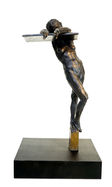Featured Artist
Gary Weisman
Gary Weisman creates bronze sculptures that resonate with timeless presence. His figures, often nude and suspended in moments of balance or stillness, draw from the classical canon while speaking to contemporary ideas of vulnerability, strength, and grace. Symbols such as apples and feathers appear throughout his work, offering quiet metaphors for knowledge, choice, and transformation. Each sculpture invites the viewer into a contemplative space where form becomes a language of empathy.
Weisman is one of the rare sculptors who completes every step of the process by hand. In his personal foundry, he crafts each work from clay modeling and mold making to lost-wax casting and patination. This full-circle approach gives his sculptures a tactile intimacy and a sense of authorship that is increasingly rare in contemporary art. His surfaces, layered with color and light, are not merely finishes but expressions of movement and thought.
%20resize.jpg)
Labyrinth (detail) by Gary Weisman, bronze, edition 1/12, 17 x 16 x 12 inches. Inquire for price.
"Everyone would probably agree art is not obligated to follow reason," Weisman writes. "Some would even assert that art gains authority when its source is not reason, when it comes from the heart or other clichés that assume an emotional or illogical but provoking source. This bronze sculpture asks that we experience art outside of reason and outside the cliché of emotions. That we not outsource art to reason and emotions but experience art as an origin."
Weisman’s work has been exhibited at the Whitney Museum of American Art and is included in public and private collections across the United States, Europe, Asia, and the Middle East. He has received numerous honors, including the Sculpture House Lifetime Achievement Award from the National Sculpture Society, as well as awards from the Museu Europeu d’Art Modern, the Art Renewal Center, and the Pennsylvania Academy of the Fine Arts. After more than thirty years teaching at PAFA, he now serves on the faculty of the Lyme Academy of Fine Arts in Connecticut.
At the heart of his practice is a belief that art is a conversation beyond language, a shared experience that unfolds in space and time. Weisman's figures do not stand apart from their environment. They participate in it fully, inviting us to do the same.
Left to right: Holding ourself, 2023. Bronze on lacquered wood base, 21 × 16 1/5 × 10 in and Upper Feather Bridge, 2023. Bronze on black lacquered wood base. 32 1/2 × 16 1/5 × 11 in. Edition of 12. Inquire for Prices


Inside the artist's foundry in Upstate New York, picturing various steps of the bronze pouring process.
Weisman was first drawn to sculpture for its ability to reveal itself immediately and simultaneously, like a gestalt. Rare among contemporary sculptors, he performs every step of his art-making process by hand, mixing clay and modeling, doing lost-wax casting in his foundry, and sanding and polishing in his studio. By paying astute attention to negative space, he crafts sculptures whose presences extend beyond their immediate forms and lend their surroundings a multidimensional quality.


"Everyone would probably agree: Art is not obligated to follow reason," reflects Weisman. "In fact, some would assert that art gains authority when its source is not reason; when it 'comes from the heart' or other clichés that assume an emotional, political, or illogical but provoking source for the art. This bronze sculpture asks that we experience art outside of reason and outside the cliché of emotions; that we not 'outsource art' to reason and emotions but experience art as an origin. My sculptural attempts, from maquette to over life size human figures composed in a compassionate naturalistic approach, ask us to abandon our preconceptions of space and gravity. But explanation is a pale shadow of the art experience.
"The bronzes do not speak of containment, but of participation. The figure is in dialogue with the surrounding space and demands acknowledgement of that space as an ontological factor; not as container. The figure does not exist outside that participation and as Gadamer states, the conversation never ends. The bronzes are the origin of a particular art experience claiming ground only in the immediate phenomenological relationships of art to viewer to space."















